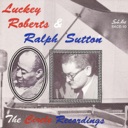Stride Piano
Jazz pianist “Fats” Waller
Pictorial Press Ltd/Alamy Stock PhotoKey Attributes of Stride Piano
Select to filter timelineThemes
- Racism/Discrimination
- Love/Relationships
- Economics/Poverty
- Migration
- Political Issues/Activism
Musical Features
- Solo
- Improvisation
- Texture
- Melody
- Tempo
- Polyrhythms
Instruments
- Piano
- Voice
“Most East Coast playing was based on cotillion dance tunes, stomps, drags, and set dances like my Mule Walk Stomp...they were all country tunes.”James P. JohnsonStride Piano Creator
Stride piano, considered to be the first piano style in jazz, is an outgrowth of ragtime. Evolving on the East Coast following World War I, it is characterized by a fast tempo and improvised solos by the right hand. The left hand covers a 10-note stretch playing single bass notes or octaves on the strong beats and chords on the less prominent beats. The stride repertoire includes original compositions as well as arrangements of popular songs of the period.
Context and History
During the Great Migration, and at the start of World War I, hundreds of thousands of Blacks left the South to escape racial oppression and legally sanctioned inequalities, and to seek better economic and educational opportunities. The migration continued for decades as African Americans moved to urban industrial cities in the North and West; Chicago, Philadelphia, and New York City were the favored destinations.
Among this group were musicians, dancers, poets, and artists, who became part of the Harlem Renaissance movement in the 1920s and 1930s. These African American creators and intellectuals challenged white paternalism by rejecting the mere imitation of white American styles. Instead, they celebrated their Southern roots and asserted their freedom to express themselves on their own terms, communicating the experiences of Black life in the urban North in new musical, literary, and artistic ways.
Piano players, taking their inspiration from ragtime, developed a more highly improvised style of swing called “stride.” James P. Johnson originated this stride technique (“Carolina Shout,” “Harlem Strut,” and “Charleston,”) but other popular stride pianists soon followed, including Willie “The Lion” Smith (“Between the Devil and the Deep Blue Sea,” “Smoke Gets in Your Eyes,” “Finger Buster,” and “Tea For Two,”), Charles “Luckey” Roberts (“Junkman Rag,” “Moonlight Cocktail,” “Pork and Beans,” “Railroad Blues,” and “Between the Devil and the Deep Blue Sea”), and Fats Waller (“Ain’t Misbehavin’” and “I’m Crazy About You”).
At this time, piano players were in great demand for clubs, rent parties, and other social events. Stride pianists participated in “cutting contests,” a competitive display of skills that became common again in “rap battles” 50 years later. In a cutting contest, players competed with other pianists to emphasize individual techniques in order to demonstrate the “better” performer. These contests were held in clubs throughout Harlem, as well as at private residences during rent parties.
Musical Features/Performance Style
Stride piano is characterized by an intense, driving performance style that is much faster than that of other pianists of the day. It also features a unique division of musical labor between the hands. The left hand provides a solid accompaniment, alternating between a bass note (on the strong first and third beats of each measure) and a higher chord (on the weaker second and fourth beats). The left hand stretches to play the interval of a 10th in the bass (known as the “pump”); this inspires and enriches the improvised solo of the right hand playing melodic riffs or polyrhythmic contrapuntal melodies. The approach of the right hand is distinguished from the “ragging” of melodies associated with ragtime. In the stride piano style, once the initial theme is played, the right hand continues with variations. Each player adapts these characteristics to create a personal but authentic individual stride style.
Lyrics
Although stride is primarily a form of improvised piano music, vocals became a part of this tradition through the innovations of Thomas “Fats” Waller. Waller used stride as a compositional device to create music for lyrics by professional songwriters. He collaborated with African American and Tin Pan Alley lyricist Andy Razaf to write “Ain’t Misbehavin’,” “Honeysuckle Rose,” and “Black and Blue,” among many others. These songs became standards in Waller’s repertoire, as well as that of jazz musicians and on Broadway.
“Jazz isn’t what you do; it’s how you do it.”“Fats” WallerStride Pianist
Many of Razaf’s lyrics provide an African American perspective on the United States, commenting on social and racial issues in the first half of the 20th century. His lyrics utilized political satire and romance themes. Razaf employed the techniques of metaphor and double entendre.
Waller’s interpretations of these songs involved a humorous display of facial and body gestures. These performances were often criticized as “clownish,” a characterization that overshadowed his innovations as a songwriter and stride pianist.
Bibliography
- Shipton, Alyn. Fats Walker: His Life & Times, Universe Press, 1988.
- Shipton, Alyn. A New History of Jazz. New York: Continuum, 2001.










